FIRST LOOK: SiS 755FX for Socket 939 Athlon 64
by Wesley Fink on December 16, 2004 12:05 AM EST- Posted in
- Motherboards
Workstation Performance
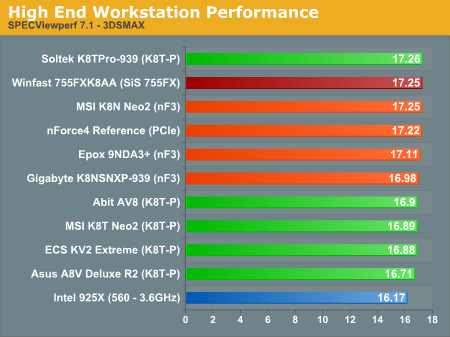
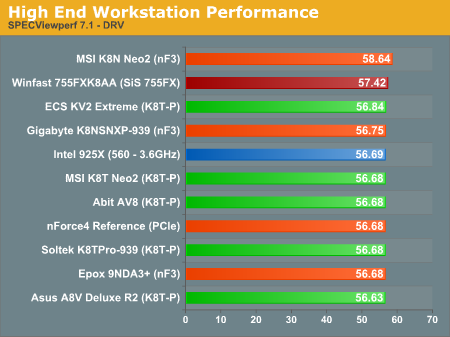
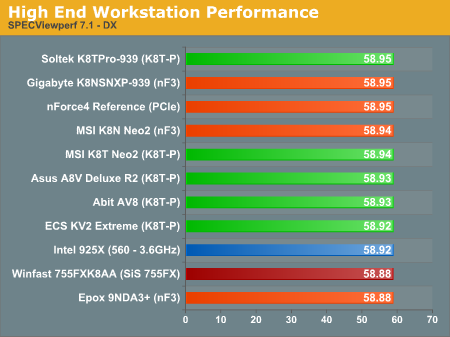
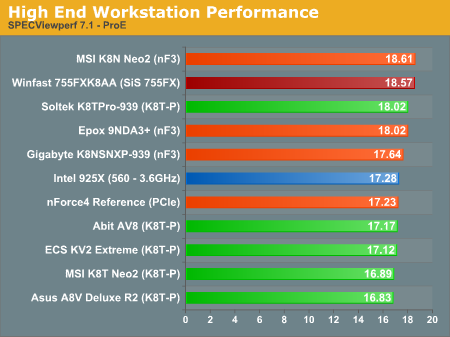
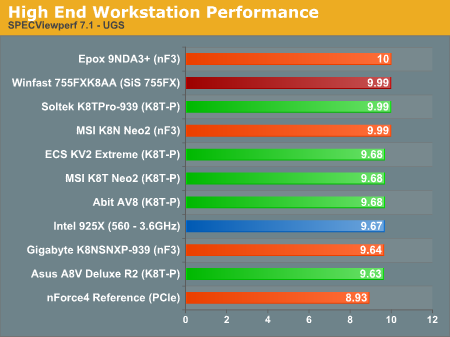
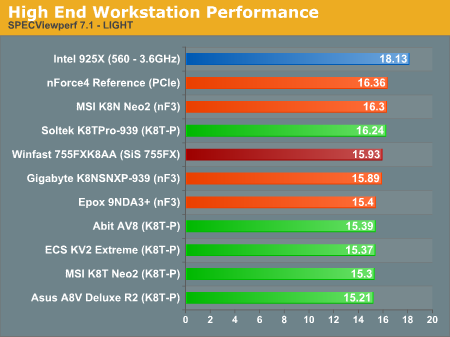
Workstation benchmark performance for the Winfast 755FX is above average among 939 chipsets. For a board that sells for such a reasonable price, this level of performance in Workstation benchmarks is really excellent.










29 Comments
View All Comments
sprockkets - Thursday, December 16, 2004 - link
ut2004 is also not Direct 9.0 either.In case you are wondering, a 3 phase power supply on the motherboard provides better or cleaner power to the processor, and lasts longer as well since you have 3 phases to balance the output on. You can read more of an explanation somewhere on Lost Circuits website.
kmmatney - Thursday, December 16, 2004 - link
With the $40 you save, you can easily upgrade from a Athlon 3200+, to a 3500+. Throw in some modest overclocking, and you are probably much better off with this board that more expensive "overclockers" board.Extreme overclocking is not really an issue, when you are saving enough money to upgrade the CPU!
The MSI "K8T NEO2-F" VIA K8T800 is also $100 at NewEgg, though...
ChineseDemocracyGNR - Thursday, December 16, 2004 - link
Now the you covered the SiS755FX it would be nice to see the ULI M1689. Reasons:1) it's cheaper. The retail price for this Foxconn board is around $100, you can get a socket 939 board with the ULI M1689 chipset for less than $80.
2) the ASRock Combo-Z motherboard (based on the ULI M1689 chipset) is capable of doing over 250MHz on the "FSB", and it will be an even more interesting choice when the 1.4 (2600+) and 1.6GHz (2800+) socket 754 Semprons are released next year.
--
"In the end, only 2 SiS 755 motherboards made it to the AnandTech labs - an ECS and a Foxconn. Both were capable budget motherboards, but neither packed the kind of enthusiast features we hoped that we would see with the 755 chipset."
It's too bad you didn't get the ASRock K8S8X (which has been discontinued in favor of the K8 Combo-Z). That motherboard had a working PCI/AGP lock and was a very capable overclocker for a budget board, as you can see here:
http://www.ocworkbench.com/ocwbcgi/ultimatebb.cgi?...
(267MHz reference clock).
For those who like SiS chipsets, there are two socket 754 motherboards based on the SiS760GX chipset (755 with integrated graphics) that also have working AGP/PCI lock: ASUS K8S-MX and ASRock K8Upgrade-760GX.
LocutusX - Thursday, December 16, 2004 - link
Foxconn probably got a really good volume deal on a particular part (of clockgen), which they found could be easily integrated into their mobo design, so they rolled with it.Gnoad - Thursday, December 16, 2004 - link
Is the clock gen problem even a problem or was it designed like this? I can't imagine any mobo company using a chipset that has great capabilities and then scaling it back on a hardware level. It just doesn't make sense. So is this an unfixible mistake or an intentional limiter?Jeff7181 - Thursday, December 16, 2004 - link
Maybe I missed it... was there any mention of when we can expect to be able to purchase one of these boards?Wesley Fink - Thursday, December 16, 2004 - link
#12 - Foxconn tells us a BIOS update cannot fix the CPU clock frequency limitation. They also just advised that a drop in Clock Generator is not available that can be substituted in this design. The board would require some redesign to use a Clock Gen supporting higher than 233.#9 - The tested Soltek is Socket 939 and it is very fast at stock speeds. If you click the motherboard tab at the top of AnandTech you will find the recent review.
Shinei - Thursday, December 16, 2004 - link
Hey now, let's not split hairs over semantics; we all know what's being talked about here...Anyway, what I was going to ask about is the clockgen on the board; is it a physical part of the board, or is it something that a BIOS update can rectify? I happen to have a pair of Mushkin Level-II PC3500 sticks that I can't take a single Hertz over 200MHz because of the poor overclocking properties of my Athlon XP 2800+, and I'd like to see how far those Winbonds will go with a chipset that can go "balls to the wall", as it were.
Wesley Fink - Thursday, December 16, 2004 - link
#10 - The SiS755FX "supports dual-channel memory". Did you explode? Then perhaps you should be more precise in your descriptions :-)We do know the difference, but while chipsets are theoretically capable of being combined with any CPU on A64 designs, they are usually tied to a specific CPU configuration - in this case Socket 939, which supports current A64 with dual-channel memory controllers on the CPU.
As for what we used to call FSB, I have been trying very hard to consistently refer to this as "CPU clock frequency", and not FSB, because it is not technically the same in an HT design. If I slipped up I apologize. The end result is essentially the same, though the route there is certainly different.
Peter - Thursday, December 16, 2004 - link
Next time I read about an AMD64 chipset "supporting dual memory", I'll explode.HELLOooOoOoOooo ... the RAM controller is in the CPU.
Also, AMD64 chipsets do not "support" certain CPU socket shapes. They are completely agnostic about what kind of and how many CPUs there are.
Finally, stop referring to the HT link as the "FSB". It is not a CPU front side bus, it's an I/O link.
New architectures require fresh thinking. Brain in gear please!